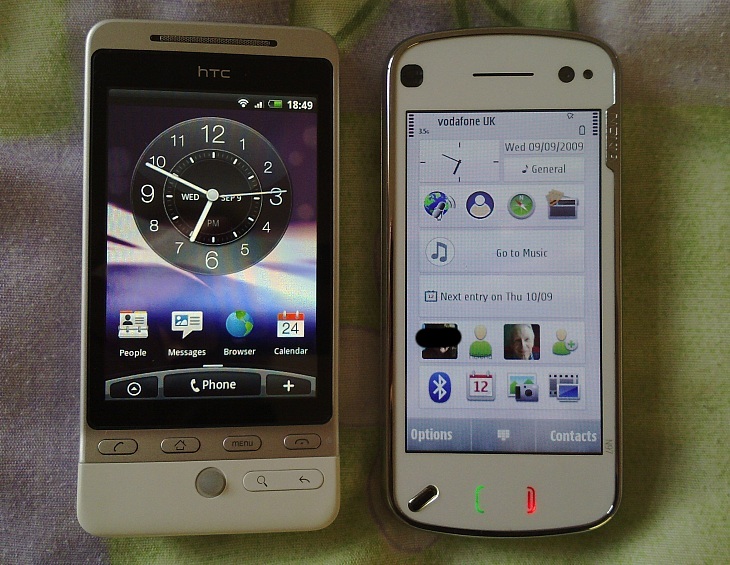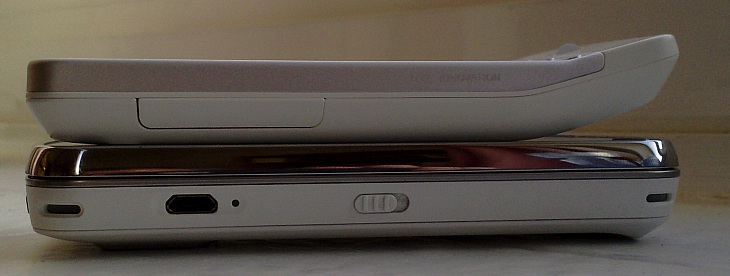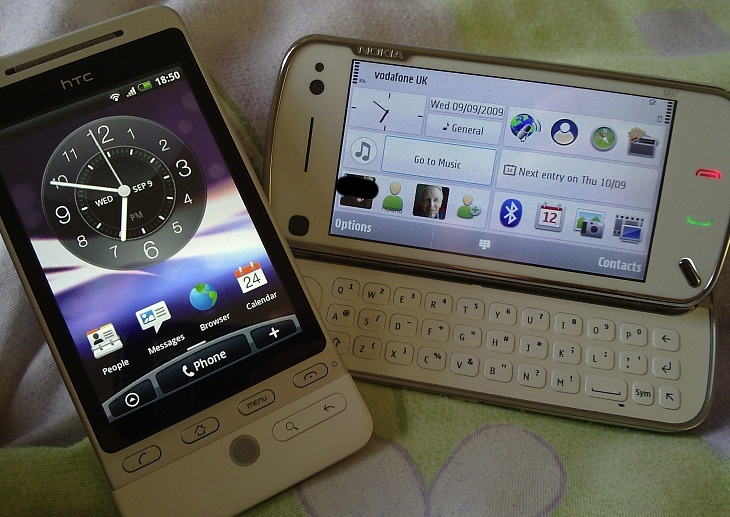
Although the form factors of the N97 and Hero are slightly different, in that the former has a swivel-out qwerty keyboard, there's still much to compare here. And I'm not just talking about the Apple iPod-esque white colour schemes. The overall size of each is similar, both have similar target markets and have similar social ambitions, both are currently flawed, and both are flagships for their manufacturer.

Let's see how the two devices stack up, spec by spec and feature by feature:
| Device | Nokia N97 | HTC Hero |
| Weight, dimensions, comments | 150g, 117x55x17mm (19mm at points), definitely 'smartphone-sized', not 'phone-sized'! | 135g, 112x56x14mm (21mm, if you take the big 'chin' into account), the chin looks weird but actually makes the Hero very secure when held one-handed. |
| Screen/mechanism | Double-jointed alloy hinge with solid ribbon cable barrier | Fixed screen, no moving parts |
| Display | 640x360 (nHD) transflective TFT, with resistive touch layer, bright, not too bad in bright sunlight | 320x480 TFT, with capacitive touch layer, almost unreadable in bright sunlight |
| Processor/RAM | 434MHz/56MB free (without Facebook widget) after booting. Speedy for most tasks, you have to hit the N97 with large web pages and multiple widgets to hit the RAM limit and start slowing things down | 528MHz/80MB free after booting, speedy for most tasks but slows down as you load up widgets and applications |
| Text input | Three row QWERTY keyboard, somewhat condensed layout, space bar optimised for the right thumb and most punctuation on functioned keys or dedicated symbol grid. Also on-screen T9-style keypad entry. | On-screen virtual QWERTY keyboard, portrait mode only in most applications. Writing aids help word entry, but text entry is fiddly for passwords, names and punctuation. |
| Base OS | Symbian OS 9.4, plenty of heritage, very function-rich | Android 1.5, responsive and modern, but incomplete in places and still feels a little unfinished |
| User interface | S60 5th Edition, largely tried and tested UI concepts, but with some distinct quirks for touch. Works well with d-pad and QWERTY keyboard, somewhat surprisingly, apart from the lack of a 'Ctrl' key and the resulting clumsy way copy and paste is implemented. | Sense UI front-end (home screens and 'scenes' [e.g. Home, Business, Social]), plus numerous re-skinnings of basic Android elements. As with Windows Mobile and iPhone keyboards, the text entry elements often obscure the main entry forms. |
| Firmware updates | Over The Air or via PC Suite/Updater. User Data Preservation. Current firmware state = buggy. | Via PC-hosted updater utility, thought to wipe the internal disk of data, so backups needed. Current firmware state = buggy. |
| Application set highlights | Ovi Store, Share online, File manager, Podcasting, Quickoffice viewers (editing version available as a paid upgrade), S60 PIM, Podcasting, Dictionary, Zip manager, Drawing, N-Gage game client, numerous Web 2.0 web site widgets, including Accuweather, Facebook, Qik, Boingo, YouTube, etc. Google Maps and Google Mail are free add-ons from google.com. | Android Marketplace, Quickoffice viewers, Footprints (instant geotagging utility), Google Talk, Google Maps, Google Mail all built-in, Peep (Twitter client), Stocks widget, Teeter (marble game), Weather widget, YouTube client |
| Web browser | Webkit based, Web next-gen, v7.1, with adequate Flash support, including video | Webkit-based, basic Flash support, videos play very haltingly |
| Navigation | GPS with Ovi Maps, with full voice route guidance on ad-hoc subscription model (first 30 days free though), GPS reception currently a little flawed, awaiting new firmware (etc.) Digital compass | GPS with Google Maps, no turn by turn navigation. Decent GPS signal, plus digital compass available. |
| Camera (stills) | 5 megapixels, Carl Zeiss optics, high quality, dual LED flash, superb results in average-to-good light conditions, camera glass scratch problems ruin LED flash photos though | 5 megapixels, average sensor, slightly washed out results, no flash, produces very poor results indoors. Focussing happens after pressing the trackball and the shot is taken 2 to 3 seconds later, making capturing a non-static subject tricky! |
| Camera (video capture) | VGA, 30fps, very clear for objects over 2 metres away(!), defocussed for close-up objects, audio is very good | CIF, 15fps max, very disappointing quality, audio very poor |
| Audio | Stereo speakers, moderate volume, tinny/narrow frequency output, excellent through headphones | Loud mono speaker, decent quality for music, good through headphones, though no EQ control |
| Video | MP4/WMV videos play back well, also BBC iPlayer compatible in the UK | MP4/WMV videos play back acceptably, no iPlayer support |
| Electrical | microUSB data and charging, 3.5mm audio jack with TV out, 1500mAh battery | miniUSB data and charging, 3.5mm audio jack, 1350mAh battery |
| Network specs | Quad band GSM, Tri band 3G | Quad band GSM, Dual band 3G |
| Wireless specs | Wi-Fi, Bluetooth, FM radio, FM Transmitter (surprisingly useful, for playing music and podcasts in the car) | Wi-Fi (auto-connects, iPhone style), Bluetooth |
| Capacity (Gigabytes) | 32GB internal mass memory, plus microSD expansion (under the battery cover) | microSD expansion (under the battery cover) |

I know I'll get shouted down for being biased, but, just as for my N97/Touch Pro 2 head to head, the Nokia N97 simply outguns the opposition - here by an even bigger margin. it's not all about specifications, of course, and I've tried to put real world observations in where necessary. But in this case, the specifications don't lie - the N97 simply does most things better and for longer than the Hero. Whether it's playing music or taking photos or handling email or browsing the Web or.... simply making phone calls, the N97 wins out.
Both devices are flawed at the moment and both are awaiting a major update - yet even here the N97 wins, since its update will be over the air and won't disturb your data (hopefully). The HTC Hero does have its strengths - there's a brave attempt to include social messaging within the fabric of the phone - it asks for Twitter, Flickr and Facebook logins when you set it up - yet it's a little half hearted - there's not even a Facebook widget or application included out of the box.
Being smartphones, both the N97 and Hero are fully extensible with third party applications, though again the Hero can't catch up - the third party software scene for Nokia/Ovi is just as 'vibrant' (read 'loads of apps, most of which are unspectacular' - but that's another rant for another day) as that for the HTC Hero and Android. And a number of the star turns (e.g. Google Maps & YouTube) are common to both anyway.
Ultimately, the Hero is a cool toy for the mobile professional, while the N97 is a serious attempt at a 'multimedia computer' (to use Nokia's term). Yes, you currently need to make a few (temporary) allowances for the latter to fully take on its role, but you also need to be patient with the Hero - I experienced several application crashes and some functionality is just not there yet in its 'out of the box' state.
Still, the Hero represents the current state of play in the Android world, with an ever-improving base OS and an innovative and highly customisable homescreen and widget set-up by a manufacturer. It'll be interesting seeing where this has got to by 2010 - combine it with a decent QWERTY keyboard and we'll have ourselves a real contender.
Steve Litchfield, All About Symbian, 11 Sept 2009
